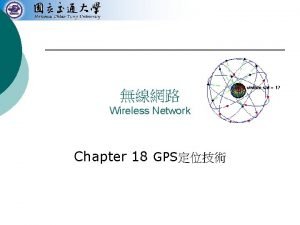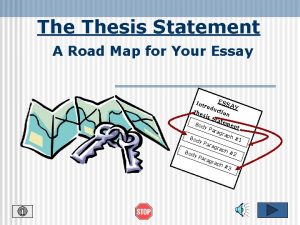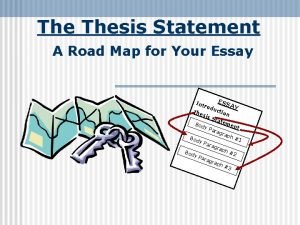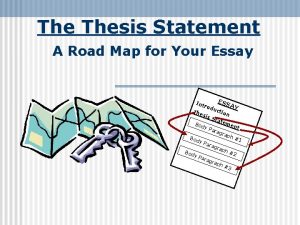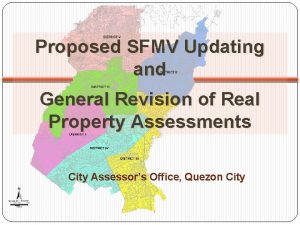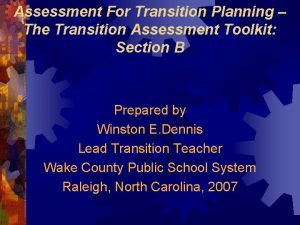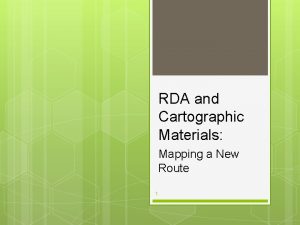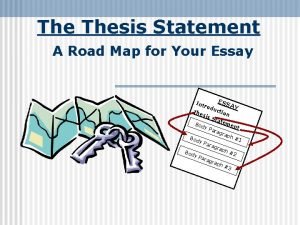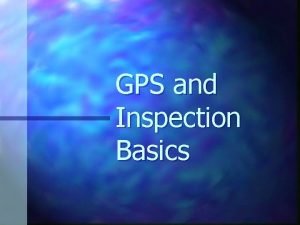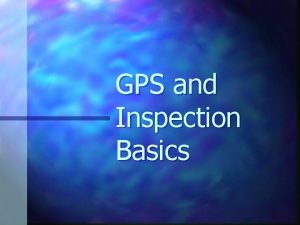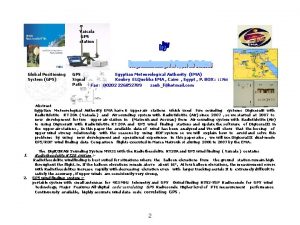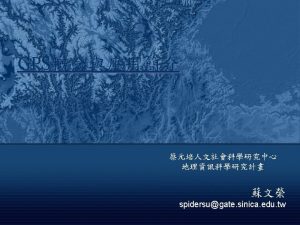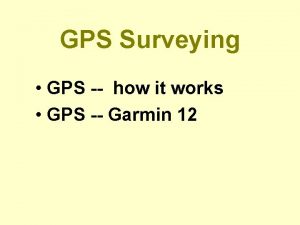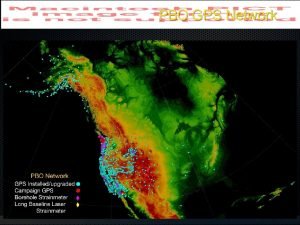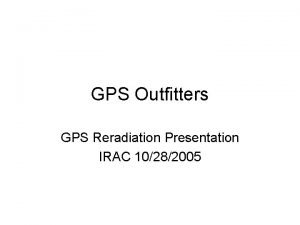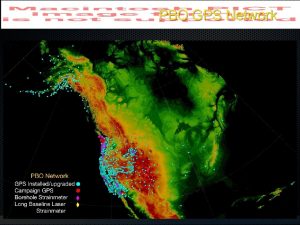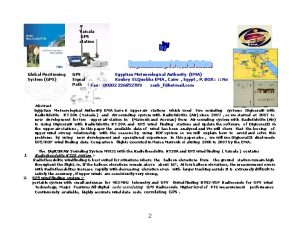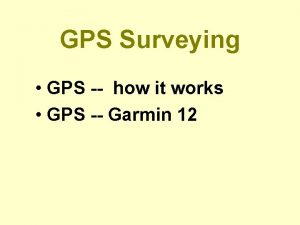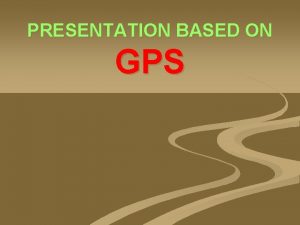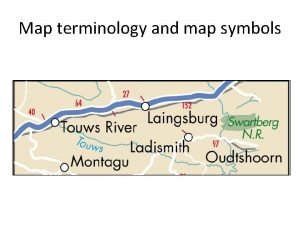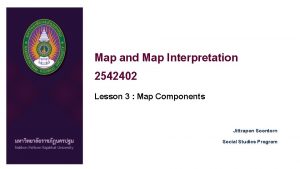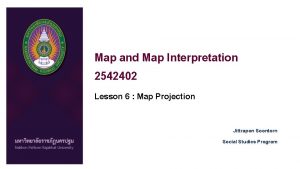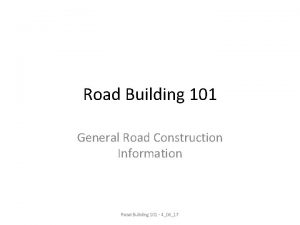GPS Road Assessments Using GPS to Map and

































- Slides: 33

GPS Road Assessments Using GPS to Map and Assess the Transportation Infrastructure

Contents of this training • What is GPS and how does it work? • Basic controls of the Garmin Etrex GPS Receiver • Setting up the receiver • Collecting a waypoint • Collecting tracks • Collecting information about a point or track • Downloading data for use in a GIS

What is GPS and how does it work? • When people talk about "a GPS, " they usually mean a GPS receiver. The Global Positioning System (GPS) is actually a constellation of 27 Earth-orbiting satellites (24 in operation and three extras in case one fails). • The U. S. military developed and implemented this satellite network as a military navigation system, but soon opened it up to everybody else. • Each satellite has an atomic clock and broadcasts the time and the satellite’s location. • GPS receivers use these signals to calculate their positions on the Earth’s surface. • Russia has a similar system (GLONASS). The Europeans are currently building a system called Galileo that should be active in a few years.

How does GPS work? • If you ask someone where you are, and they say you are 1000 km from Boise, you don’t know much. • This only tells you that you are somewhere on a circle that extends 1000 km from Boise.

How does GPS work? • If you ask someone else, and they say you are 1110 km from Minneapolis, you know a bit more. • This tells you that you at one of two points, where the circles intersect.

How does GPS work? • If you ask a third person, and they say you are 990 km from Tucson, then you know where you are: Denver • You are at the one location where all three circles intersect.

How does GPS work? • Your GPS receiver does the same thing, but in 3 dimensions and using at least 4 satellites, often more. • The satellites, of course, are moving but they broadcast an almanac that describes their orbits, so your receiver knows where each satellite is at each moment.

Basic controls

Top level pages • • • Press the PAGE button (top right) to move between the pages of information. Pressing ENTER, UP, or DOWN will have different effects on each page. If you are in a sub-menu of a given page, pressing PAGE will cancel what you are doing and take you back up one level. IF YOU GET LOST IN THE MENUS: press PAGE until you see one of the pages above.

Setting up the GPS Receiver Overview – Set the coordinate format – Set the datum – Clear the track log (if all previous data has been downloaded) – Clear the waypoint memory (if all previous data has been downloaded)

Setting up the GPS Receiver • Set the coordinate format and datum – All maps have a coordinate system and datum. Your GPS must be set to the same coordinate system and datum as the map you are using. – The earthquake operation has used the Latitude-Longitude coordinate system (also called the Geographic Coordinate System) and the WGS 1984 Datum (also called WGS 84).

Setting up the GPS Receiver • Latitude: angle north or south of the equator • Longitude: angle east or west of the prime meridian

Setting up the GPS Receiver • Combined, these two measures provide a location on the surface of the Earth

Setting up the GPS Receiver • Geographic coordinates can be expressed in several ways: – Decimal degrees: 34. 73459 – Decimal mintues: 34° 44. 0754’ – Decimal seconds: 34° 44’ 04. 524” • Most maps produced by the HIC and UNJLC have shown coordinates in the first format: decimal degrees

Setting up the GPS receiver • Go to the Menu Page • Use the DOWN button to highlight Units • Use the ENTER button to select.

Setting up the GPS receiver • Select the Position format, use ENTER to select a different value. Set the Position Format to hddd. dddddd (decimal degrees). • Set the Map Datum to WGS 84. • Set units to statue (miles, feet) or metric.

Setting up the GPS receiver • Clearing the waypoint memory – Before beginning to collect data, we should clear the memory (unless there is valuable data already in the memory) – From the Menu Page, select Waypoints – Select Delete All – This removes all waypoints in the memory. – You can also delete a single waypoint by selecting it from this screen.

Setting up the GPS receiver • Clearing the track log – Go to the Menu Page. – Select Tracks – Clear the Track Log to make room for recording more tracks. – Warning! When the track log fills, it will begin overwriting the oldest parts of the track possibly deleting valuable data. The amount of track that can be recorded varies with the memory of the GPS receiver, but usually is more than 8 hours.

Collecting waypoints • A waypoint is simply the coordinates (latitude, logitude, and elevation) of a location that you want to record. • You can store hundreds of waypoints in most GPS receivers before filling the memory. • To collect a waypoint, go to the Menu page and select Mark.

Collecting waypoints • The name of the waypoint is shown (001). • The coordinates and elevation are shown. • Select OK to save the waypoint. • Any of these can be edited by selecting them. This is how you can enter waypoints for locations other than your current location.

Collecting tracks • A track is a trail of points showing where you have moved. • The GPS will automatically collect these tracks. When the track log is full, the oldest tracks will be deleted to make space.

Tracks and routes • A route is a sequence of user defined waypoints that you want to move through. • It is not commonly used for land navigation. • We will not address the use of routes in this course.

Saving your work • The short answer is, you don’t need to do anything to save your work. • The GPS Receiver will save the waypoints and tracks as you go. • You can turn off the GPS at any time. • However, don’t let the GPS turn itself off due to low battery, this sometimes results in data loss. • If you fill the track log, the oldest data will be erased as new data is added.

Exercise: Collecting GPS Data • Acquire satellites • Collect 3 GPS waypoints at least 200 meters apart • The GPS Unit will track your movements

Collecting information about a waypoint • The GPS only records the name of the waypoint and its location. • You should record additional information separately, which can be joined later to the downloaded GPS data for display on a map. Example of data that you might record for school waypoints Waypoint # Name # of Students 001 Lisalakot 25 002 Benabad 57 003 Ingradakot 32

Downloading data for use in a GPS Installing DNR Garmin • • Run the DNR Garmin Install from the Quake. Zone Map. Kit CD Launch DNR Garmin using the shortcut it placed on your desktop. Ignore and OK any “Port does not exist” errors. You may get a window (initial run only) asking if you want to use a particular UTM zone and datum. Click ‘NO’ and say ok to the next window. Choose GPS|Set Port and choose the port where your GPS will be connected. Choose GPS|Set Baud Rate and choose 9600. This is the default for Garmin GPS units. Connect your GPS to the computer and turn it on. Choose GPS|Open Port. The version of the software on your GPS should display in the DNR Garmin window, and the status bar (bottom left of the DNR Garmin window) should say ‘Connected’.

Downloading Points in DNR Garmin • • • Choose Waypoint|Download. All waypoints in the unit will be downloaded. Do not click any of the radio buttons (for Track, Route, etc). The waypoint numbers are in one of the fields (usually called ‘ident’). You can select and delete (with the ‘X’ button) any waypoints you don’t want. Choose File|Save to|File. Save as comma delimited text. Place the file in the location where you want to keep your map data. Change the file extension to. CSV

Downloading Tracks in DNR Garmin • • • Choose Track|Download. Any data in the table will be replaced with track points. All data in the track log will be downloaded as a series of point locations. Do not click any of the radio buttons (for Waypoint, Route, etc). Ignore any errors about differences in the number of tracks sent by the GPS and received by the software. Choose File|Save to|File. Choose Save As Shapefile (unprojected). You can save as point, line, or polygon, depending on how you want to display the data. In this case, save as line. Place the file in the location where you want to keep your map data. This will generate several files (3 to 6) that must be kept together for the shapefile to work. Shapefiles can be opened in Arc. Explorer.

Limitations of DNR Garmin • Only works with Garmin GPS receivers • Another software, GPS Utility (GPSU), works with all units, but the full version isn’t free. • The freeware version of GPSU limits you to – 100 waypoints (usually enough for a day or two of fieldwork) – 500 track points (usually less 2 hours of tracking)

Key features of GPSU • Download files from GPS receiver and save as – Shapefiles – Dbase Files – Text files • Load coordinates from text files and dbf files, which can then be converted to shapefiles • Allows a simple map view of the data with some editing capability

An alternative to downloading waypoints • If you only are collecting a few waypoints, it is possible to manually enter the coordinate information. • Use the Waypoint option on the menu page to review the waypoints one by one. • Record the latitude and longitude for each point. • Record elevation if you are interested. • This data can be entered into Excel later and used to create spatial data in Arc. Explorer.

Adding information to a waypoint for display on a map • The waypoint CSV file you have created contains the waypoint number and coordinates for each location you recorded. • It does not contain information about what the point represents, such as the school name. • We will add this information in Excel

Adding information to a waypoint for display on a map • Open the CSV in Excel. • Define the format for the coordinates as number with 5 decimal places • Delete any columns you don’t want. • Add columns for information about the waypoint, such as School name and # of students. – Keep column titles to 8 characters or less, no spaces. – No blank cells are allowed in the last column. IDENT NAME STUDENTS 001 Lisalakot 25 002 Benabad 57 003 Ingradakot 32
 Gps gps gps
Gps gps gps Modulo positioning
Modulo positioning What is paved and unpaved road
What is paved and unpaved road Thesis and roadmap
Thesis and roadmap Thesis road map
Thesis road map Thesis/claim and road map
Thesis/claim and road map Thesis statement road map
Thesis statement road map Thesis statement example
Thesis statement example Thesis road map
Thesis road map Essay road map
Essay road map General revision of assessments and property classification
General revision of assessments and property classification Informal and formal assessment
Informal and formal assessment Formal and informal assessment
Formal and informal assessment Characteristics of formative evaluation
Characteristics of formative evaluation Physical fitness components and tests grade 9
Physical fitness components and tests grade 9 Summative evaluation
Summative evaluation Challenges in embedded system
Challenges in embedded system Embedded system example
Embedded system example Gps moving map in embedded systems
Gps moving map in embedded systems Gps moving map in embedded systems
Gps moving map in embedded systems Road to emmaus map
Road to emmaus map Mole conversion chart
Mole conversion chart Reading road map
Reading road map Ecr rod supplier
Ecr rod supplier Which statement describes zheng he’s travels?
Which statement describes zheng he’s travels? Cellular respiration road map
Cellular respiration road map A road map indicating the direction of systems development
A road map indicating the direction of systems development The 10-step road map
The 10-step road map Silk road mind map
Silk road mind map Rda maps
Rda maps Thesis road map
Thesis road map Sql road map
Sql road map Akkalkot to kurnool bharatmala project map
Akkalkot to kurnool bharatmala project map Thesis statement road map
Thesis statement road map
